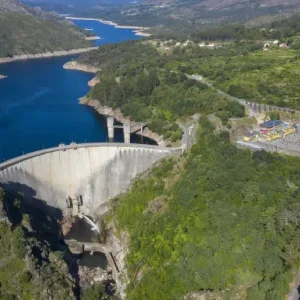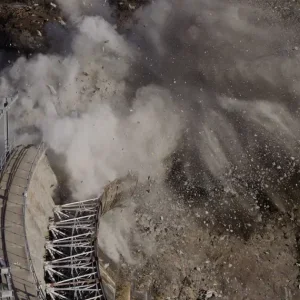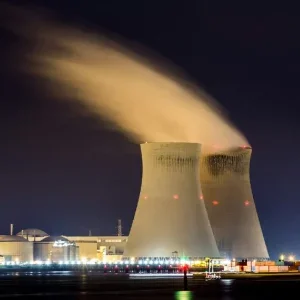IN BRITISH COLUMBIA, a province in Canada, a water use planning process has been in place for several years. In July 2001, International Water Power and Dam Construction profiled the water use planning process with the Ash River Water Use Plan (WUP), one of BC Hydro’s thirty hydroelectric facilities, as a case study. Much has happened with the Ash River WUP since then, with the most notable being the consultative process ending with a positive result for all participants.
British Columbia’s Provincial Government issued the Water Use Plan Guidelines, which were developed by an interagency group, in February 1999. These guidelines set out a new process to better manage the Province’s water resources. The development of WUPs for power and other control facilities are carried out as part of the licensing procedures of the British Columbia Water Act. BC Hydro voluntarily initiated a review of all of its hydroelectric water licenses to have new WUPs in place within five years.
The WUP process reviews each facility to look at environmental, social, and economic impacts to find a balance for all water interests.
A consultative committee consisting of local, provincial, and federal groups representing a diversity of interests is voluntarily formed to review the hydroelectric facility. A BC Hydro project team works to support and assist the committee in making informed choices.
For Ash river, a consultative committee of 16 members (four dropped out of the process as they were comfortable with their issues being represented by others on the Committee) formed in September 2000 to review the Ash river hydroelectric facility on the storage and release of water – physical aspects of the facilities, along with legal definition of aboriginal rights and title, are not part of the WUP process. The committee structure was inclusive, allowing both active and observer status, as seventeen organisations or members of the public monitored the process as observers. The committee met ten times from October 2000 to June 2002. During this time numerous subcommittee meetings (fish, wildlife, archeological) were held in support of the committee. The WUP participants took ownership in the final decision because they were included at the very beginning of the process. The end result of nearly two years of work was a consensus-based operating regime that is expected to positively impact power, fisheries, wildlife, and traditional and cultural interests.
The Ash river system
The Elsie Lake Reservoir is the start of the Ash river hydroelectric facility, formed in 1958, approximately 40km north west of Port Alberni. It is centrally located on Vancouver Island. One main dam and four saddle dams impound the 75ha reservoir, with two release valves in place to provide fish flows down the Ash River. An intake structure at Elsie provides water flow through a tunnel and penstock to the 27MW powerhouse located 7.4km away on Great Central lake.
The Ash river flows into the Stamp river and eventually into the Somass river before emptying into the Alberni Inlet at Port Alberni. Multiple lakes feed into the river system, including Great Central lake and Sproat lake.
There are many uses for water in the Ash river watershed. Early in the review process, the consultative committee confirmed the issues, objectives and performance measures they would use to gauge how well the proposed operating alternatives satisfy individual objectives. The interests considered by the committee were: traditional and cultural, domestic water supply, fisheries, flood management, recreation, recreation, wildlife, and power generation.
Performance measures
Multiple performance measures were used to help consultative committee members weigh how their objectives were impacted during the tradeoff analysis stage. They assisted in determining the degree to which their objectives were achieved with each operating alternative.
The measures revealed how good the alternative was, as well as providing a consistent set of criteria by which to compare the operating alternatives (measuring which is better).
The following example illustrates how performance measures are used to review how an alternative flow regime would impact an objective.
• Recreation objective: Maximise recreation on Elsie Lake Reservoir.
• Performance measure: Number of days reservoir elevation is between 327.5m and 329.5m between 24 May and 15 October.
Therefore, those operating alternatives that score highly on this recreation performance measure would benefit recreation on the reservoir.
From the analysis of all performance measures, a preferred operating alternative is developed and agreed upon that provides the best balance between all competing water uses.
Through discussion and review of performance measure results, the participants came to understand and accept each of the results and the range of impacts.
Water use planning for BC Hydro on system-wide basis has been very beneficial in developing the environmental tools on how to best measure all of the committee-specific interests. This tool building concept is open to the participants, not just BC Hydro, and also applies to how to best use decades of inflow data (in this case Ash river) for the computer power modelling of various operating alternatives.
Operating alternatives
The tradeoff discussions on various
operating alternatives begins by asking the consultative committee which operating alternatives should be modelled first, and once done and results examined, what other alternatives or modifications should be modelled. This transparent and interactive process allows for committee ownership and learning, as not only do they control what alternatives are modelled, but the modelled results may differ from some committee members’ perceptions – it can change people’s choice sets. For Ash river the operating alternatives included considerations for traditional and cultural use in the Elsie Lake reservoir and Ash river, power generation, and provision of fish and wildlife habitat. The consultative committee’s focus was on protecting First Nation archeological resources, managing water use by maintaining power generation capabilities for the economic benefit of the Province of British Columbia, and providing more fish habitat by releasing additional water down the Ash river.
There was significant discussion on the tradeoff between releasing water from Elsie dam for fish in the Ash river and maintaining targeted reservoir elevation levels for other interests. Because of the relatively small storage capacity of the reservoir, especially during dry years, it may be difficult to maintain flows down the Ash river and maintain targeted reservoir elevations. Another topic of discussion was how to balance fish flows in the Ash river with discharges from the power house into Great Central lake, which ultimately impacts fish habitat in Great Central lake and the Stamp river.
The solution
As much as possible, the goal of the WUP programme is to strive for consensus on a set of operating rules for each facility that satisfies the full range of water use interests at stake, while respective of legislative and other boundaries. However, is not a requirement, and perhaps for this reason people seem more inclined to work together. For the Ash river WUP, the consultative committee were able to reach consensus on the final operating alternative. Highlights include:
• A gain in revenues for power generation to the Province of British Columbia (BC Hydro is a Crown corporation) for modifications to the operating regime estimated at approximately US$378,000 per year. The existing water licence allowed for a maximum amount of water per year to be diverted into Great Central lake. With this restriction being removed, rather than having to store water towards the end of the year, it can be used for power generation.
• Water release from Elsie dam of 3.5m3/sec down the Ash river from May through October, and 5m3/sec for the rest of the year. With the existing water licence, discharges at the dam can vary to meet a minimum flow requirement of 3.54m3/sec at a water monitoring station located several kilometres downstream – natural inflows between this stretch allowed for less of a water release. The flow increase is expected to benefit fish habitat and indirectly, wildlife.
• A 48-hour pulse fish flow of 10m3/sec once per month in August and September. The pulse release may be timed with storm events, and is to allow for fish migration over natural barriers, such as falls in the Ash river. The existing licence did not provide for pulse flows.
The consultative committee supported conducting monitoring studies and mitigative measures for archeological, wildlife and fish interests in the Ash river system over the next few years. The committee also supported a communications protocol between BC Hydro, which operates the Ash river hydroelectric facility, and NorskeCanada, a pulp and paper company that operates the dam at Great Central lake to maintain the lake level and Stamp river flows. The protocol is to enhance the coordination between the two facilities, especially during low inflow or dry years, so NorskeCanada can operate the dam accordingly.
Monitoring and WUP review
The consultative committee used existing information, information collected during the WUP process, and professional judgement to come to a consensus-based recommendation for a new operating regime, considering all interests, for the Ash river hydroelectric facility.
To help determine if changes in operations will be beneficial, the committee recommended a number of monitoring studies to obtain more information, confirm the perceived benefits, and inform future decisions on how to operate the hydroelectric facility.
The consultative committee also developed a consensus-based recommendation for the membership and the mandate of the Ash river WUP Monitoring Advisory Committee. The advisory committee will review the monitoring study results annually and assess the need to recommend an early WUP review five years after receiving regulatory approval.
Now in step nine, BC Hydro prepared a draft Consultative Committee Report that was sent to the consultative committee in October 2002 for comment and input. BC Hydro’s WUP is being drafted from the recommendations contained in the Consultative Report, with both reports to be sent to the Provincial Comptroller of Water Rights for regulatory review under the Water Act by the end of 2002. Once the review and approval is completed, which is expected to take 6-12 months, BC Hydro will implement operational changes as directed by the comptroller.
Each of BC Hydro’s hydroelectric facilities are unique and so are the issues and consultative committee tables. The Water Use Planning Guidelines are in place as goal posts. The WUP process is designed to be sufficiently flexible to meet the needs of different facilities and owners/operators. While it is expected that the steps in these guidelines will be followed, the approach to and extent at each step are adapted to suit the particular circumstances of each facility and operator.
However for each WUP the facilitator must modify the details of the process to cater to the needs of the committee. Not only is there a range of expertise, but abilities to understand technical data. Committees not only rely on the BC Hydro project team and the independent facilitator for clarity of information, but on fellow committee members. A level of trust and rapport develops.
At the end of the day all participants have a better appreciation on the complexities of operating a hydroelectric facility, and just as importantly, a better understanding and respect for the interests and values of each representative. This can also include clearing up any preconceptions. It provides an opportunity for BC Hydro to talk to all the stakeholders at once rather than on a one on one basis that often pitches one interest group against another.
In the structured process of the WUP format of value-based decision making, in the invitation to articulate their values, it provides a vested interest for all parties to agree on an operating alternative. This was achieved for Ash river.
Related ArticlesSpotlight on… Canada
| 13 Steps to the Water Use Planning Process |
| • 1) Initiate a WUP process for the particular facility. • 2) Scope the water use issues and interests. • 3) Determine the consultation process to be followed and initiate it. • 4) Confirm the issues and interests in terms of specific water use objectives. • 5) Gather additional information on the impacts of water flows on each objective. • 6) Create operating alternatives for regulating water use to meet different interests. • 7) Assess the tradeoffs between operating alternatives in terms of the objectives. • 8) Determine the document and areas of consensus and disagreement. • 9) Prepare a draft WUP and submit it to the Comptroller for regulatory review. • 10) Review the draft plan and issue a provincial decision. • 11) Review the authorised WUP and issue a federal decision. • 12) Monitor compliance with the authorised WUP. • 13) Review the plan on a periodic ongoing basis. |






